Are you considering a no-meetings day at your company? It’s a good idea.
As you’re reading this, there’s probably a meeting on your calendar that should have been an email.
From a high-level perspective, meetings make a lot of sense. They give you a chance to collaborate, get feedback, and discuss important issues with others who have a different perspective.
However, meetings often take too much time away from productive work.

In one study, CEOs attended an average of 37 meetings per week and spent 72% of their total work time in meetings. It’s no wonder they worked an average of 62.5 hours every week.
You can’t bounce from meeting to meeting every day and expect to get anything done. In fact, the Muse found that 92% of executives multitask during meetings to get their work done. Read more about time and productivity stats here.
At Hubstaff, productivity is a priority. We introduced no-meeting days for our entire team in 2021.
Here’s how we did it, plus some tips to help you plan your own no-meeting days at your company.
Boost your team’s efficiency with Hubstaff's productivity tools
What is a no-meeting day?
A no-meeting day is exactly what it sounds like: it’s a designated day when meetings can’t be scheduled. At Hubstaff, we have at least one no-meetings day every week. These days help you and your team put personal productivity first.
This time belongs to you. Work on a passion project, catch up on emails, or get through your to-do list without interruptions.
Big companies and busy individuals alike boost their productivity with no-meeting days. At Facebook, meetings are banned on Wednesdays.
One author and public speaker schedules “untouchable days” during which he turns off all forms of communication, puts his phone in airplane mode, and eliminates all interruptions.
No-meeting days are even more powerful in a remote company.
You and your team have more control over typical office distractions when you work from home. Turn off your notifications, close your email, and get some deep work done.
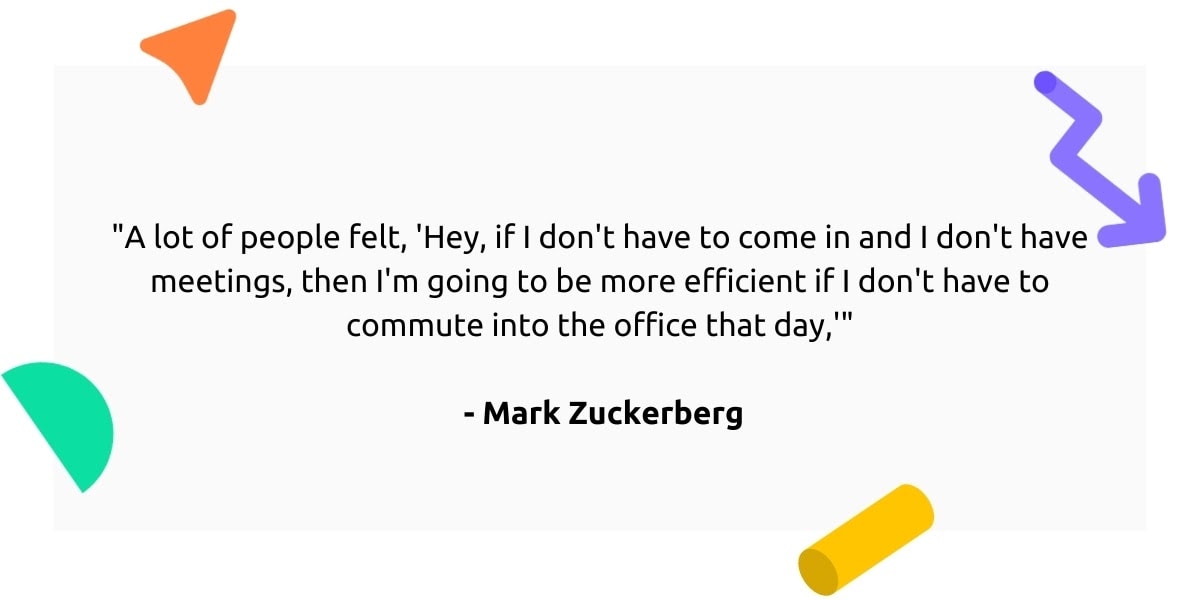
If you want to try no-meeting days at your company, great! We applaud your smart decision. This article lays out the steps you should take to make that a reality.
First, let’s look at some of the reasons this strategy works so well.
How’s your productivity?
Hubstaff helps you measure and maximize productivity so you can get more done. Try it for free today.
Pros of having a no-meeting day at work
1. Finding a flow
The zone is not just a place reserved for Jimi Hendrix guitar solos or Stephen Curry three-point shooting displays. Even in a 9-5 setting, finding a rhythm helps you be more productive.
Mihaly Csikszentmihalyi dubbed this state of consciousness the flow. Operating in this state helps us increase our confidence and overall self-esteem. Think of it as a heightened state where all distractions are blocked out.
Finding a rhythm is easier on some days than others. However, it’s easier to focus when you don’t have to keep an eye on the clock for your next meeting.
If you’ve ever dragged yourself away from your work to make it to a meeting on time, you know exactly how frustrating this is.
2. Eliminating unproductive meetings
It’s easy to hate meetings. Even the Harvard Business Review agrees that it’s time to make a change.
Of 186 senior managers they surveyed across multiple fields, 71% felt that meetings were unproductive and/or inefficient.
Perhaps the most surprising discovery is that these same managers are often the ones that defend meetings as a necessary evil.

Managers use meetings as a communication channel to invite input from all levels.
While their intentions are good, these leaders often stifle productivity in the process. A no-meeting day can help.
3. Creating problem solvers
How do no-meeting days make us more productive? For one, they incentivize problem-solving.

Organizations that have too many meetings build a culture where people can’t make decisions without consulting the boss. The first reaction to a new idea is “let’s meet about it.”
Soon, people feel like they have to get input and permission before they try something new.
A no-meetings day means you have to prioritize your available meeting time more carefully. Some meetings don’t make it into the schedule.
When you minimize the number of meetings on your calendar, you also create a culture of problem solvers.
What happens when a problem comes up on your no-meetings day? If a day’s worth of work hangs in the balance, your team must find solutions to their problems without calling you.
Note: if you still find yourself struggling to create problem solvers, it might be best to address your managerial style or the culture as a whole.
4. A more focused team
One of the most overlooked downsides to a day full of meetings is the lost time between them.
Let’s suppose you wrap up one meeting and have an hour of downtime before the next. By the time you grab some water, take a bathroom break, and check some emails, it’s already time to start shifting your attention to the next meeting.
Don’t fall into the trap of viewing every block of time as a chance to be productive.
There’s a natural ebb and flow to your energy levels, and it’s much harder to focus when your energy is low.

Meetings take up a lot of mental resources. There’s a natural recovery time before you can work at peak efficiency again.
Without meetings to interrupt your day, it’s much easier to focus.
5. Happier, healthier team members
People at all levels of your company will appreciate the change.
At Hubstaff, more than half of our team members have seen significant benefits from our new no-meeting day policy. These team members have seen an uptick in their performance and overall focus.
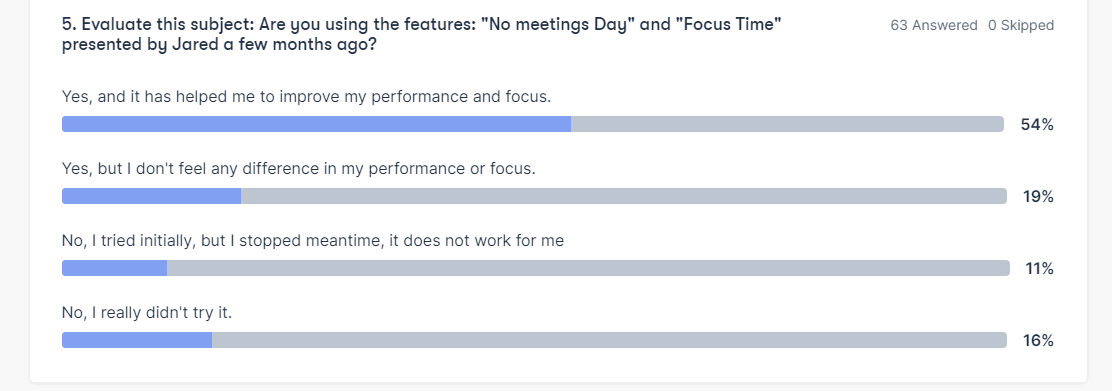
Everyone’s preferences are different. Some teams may be excited by the opportunity to focus on independent work. Other teams may worry that you won’t be available to answer their questions or provide feedback on projects they’re working on.
Even if they’re hesitant, though, your team members need time to focus and work.
If one day per week without meetings is going to derail progress, then you should take a step back and look at the way your company gets things done.
How to establish a meeting-free day
The goal of a meeting-free day is to establish boundaries and increase productivity.
Protecting your time is crucial for continuing to grow your team and/or company. That said, your team’s time is just as important as yours.
That’s why the most important part of implementing a no-meeting day is communication. Surveys through Slack or email are a good place to start.
Ironically, setting up a no-meeting day might actually require a meeting.
Selecting the best no-meeting day for your team
Our marketing team here at Hubstaff decided to give Fridays a shot. Here’s why this works best for us:
- We have various sub-teams that have check-ins and sprint meetings Tuesday through Thursday. Instead of moving these meetings, we built around them.
- Planning is everything. Monday is the start of the workweek, but taking personal time on Friday helps us hit the ground running the following week.
- Work-life balance is crucial. Hubstaff is a fully remote company spanning 27 countries and 12 time zones. Our marketing team is equally diverse. We’ve found that late Friday meetings can quickly derail weekend plans.
Other teams at Hubstaff chose different days for different reasons. We found that instead of trying to have one specific day for the entire company, it made more sense to leave the decision up to smaller groups.
For a meetingless day to truly work, your team should have input into the days that work best for them. If you’re still having trouble deciding, tools like Hubstaff can help.
Use time and activity reports to identify your team’s most active days. These are logical places to put your no-meetings day.
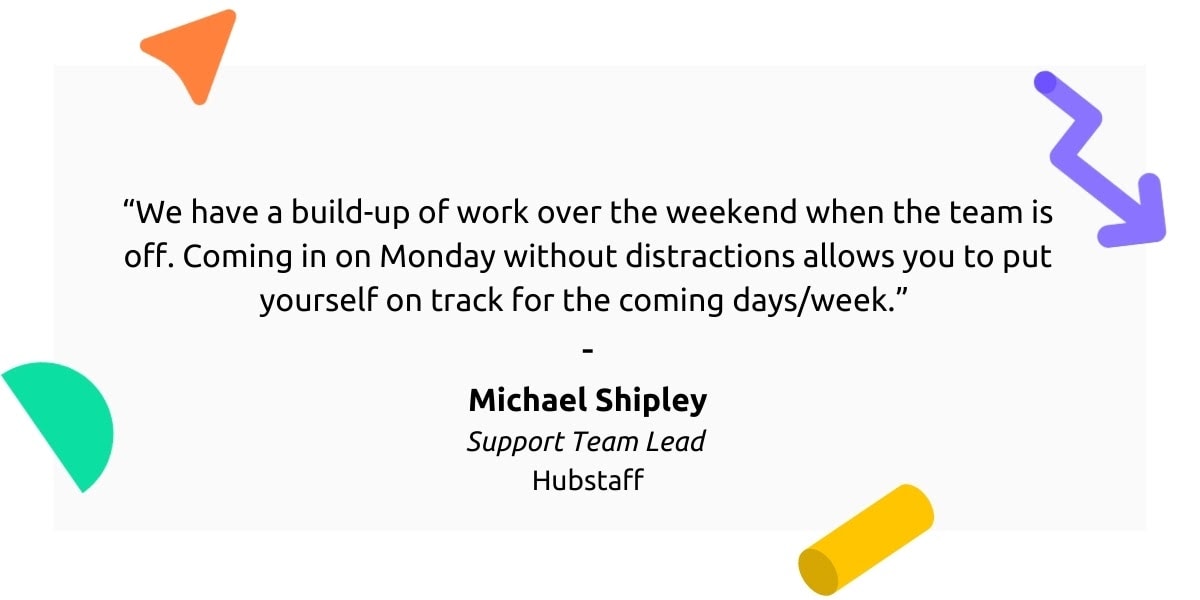
Here are some other ways to find a good day to ban meetings.
- Time it around the start or end of your Sprints
- Try to avoid meeting between waves of work so there are opportunities to address barriers, deadline adjustments, etc.
- Let teams select their own day (like Hubstaff does)
Find your team’s peak productivity with Hubstaff
Track time and gain visibility into how your team gets things done.
Even after implementing a no-meeting day, check in with team members to see if this day is still working best for them.
You may need to work on enforcement, too. Team members will be tempted to ignore the new no-meetings rule when they’re busy and need to find a meeting time.

Make sure your leaders are on the same page. A no-meetings day only works if people really don’t have any meetings.
Handling pushback
Including your team in this decision won’t eliminate pushback entirely. Team members (and managers) that are used to scheduling impromptu meetings may struggle with the concept of a no-meeting day.
The important thing to remind them is that you’re still available. Just because a no-meeting day is on the calendar doesn’t mean your team isn’t allowed to:
- Ping you questions on slack
- Have a quick video call to solve a problem
- Set up a meeting in emergency situations

If your team is still struggling with your no-meeting policy, consider reassessing the way you communicate entirely. At Hubstaff, we have found great success in implementing a communication manifesto.
Our manifesto is designed to outline the proper communication etiquette at Hubstaff. If you believe your company could benefit from something similar, you can use ours as a jumping-off point.
Addressing a deeper problem
No-meeting days are a nice first step, but there’s a deeper issue that needs to be addressed.
Publications like Forbes argue that no-meeting days miss the mark because they prolong the inevitable: unproductive meetings.
The goal of no-meeting days is to incentivize individual problem solving and productivity. If you’re still struggling with productivity, it’s hard to argue with this criticism.
No-meeting days are not very impactful if you have an underlying problem. Maybe your managers use meetings because they’re insecure in their leadership, or you might just have bad meeting habits that sap your productivity.
Here are a few tips to help you combat some of the most common meeting-related issues.
Have more productive meetings
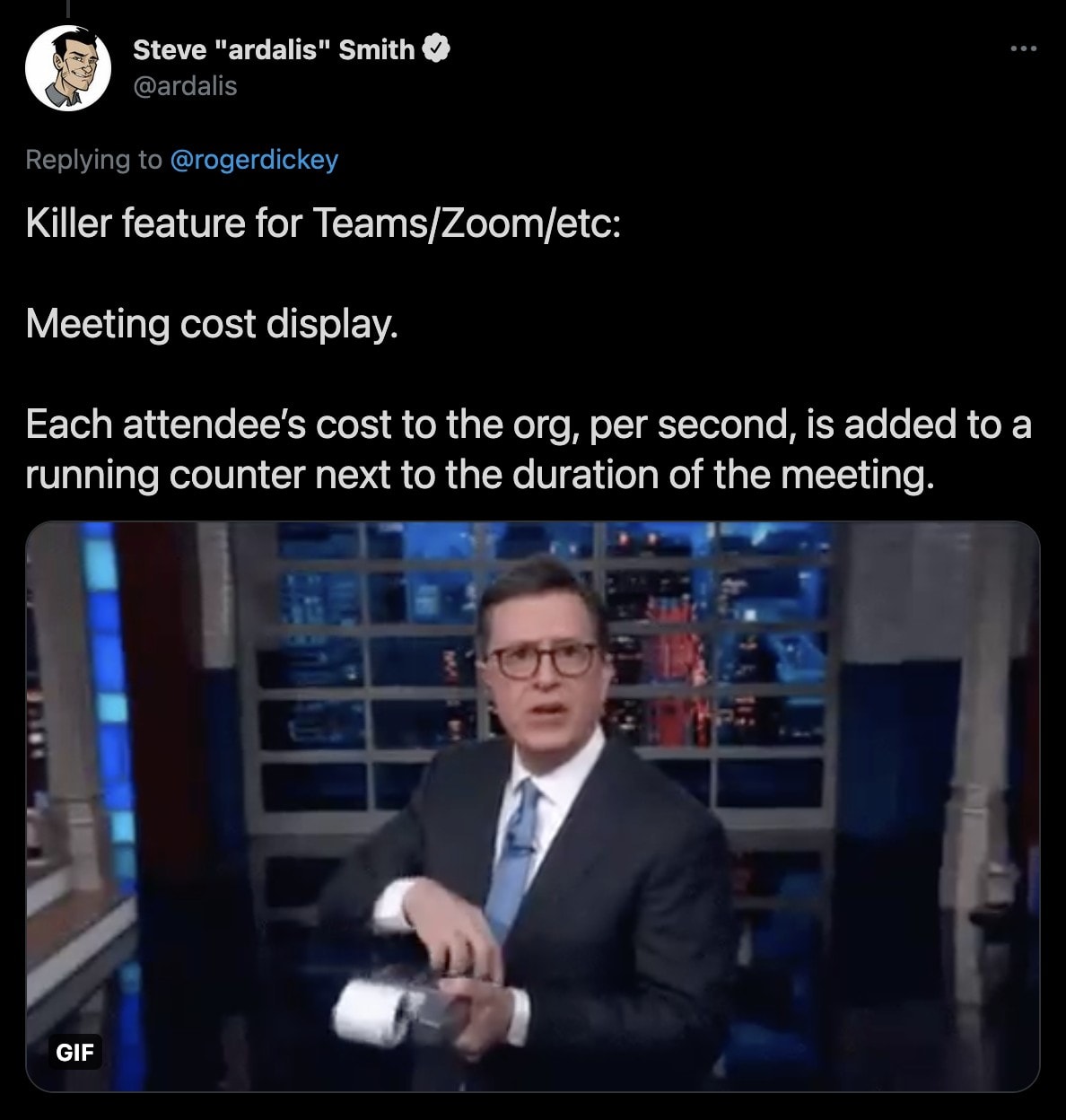
A no-meeting day holds little weight if the meetings you do have aren’t productive. That’s why Hubstaff’s Director of Marketing Courtney Cavey strives to approach meetings as efficiently as possible:
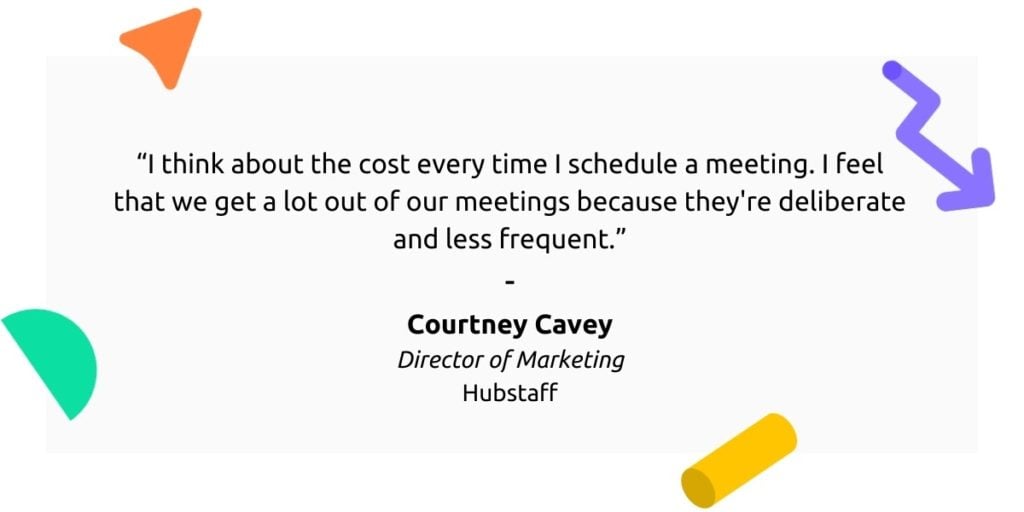
When you do have to meet, how do you keep these meetings as productive as possible?
- Have an agenda. This seems like common sense, but only 37% of US meetings have a team meeting agenda. With no meeting outline, each attendee will bring their own goals to the table. This makes it way too easy to get off-topic.
- Promote turn-taking. The point of a meeting is to get input from everyone involved. Taking turns to ensure everyone has time to speak is crucial for keeping things on track.
- Start and end on time. This is easier said than done but extremely important. Hold your team and yourself accountable for keeping meetings on time and on target.
Focus time
It can be hard to implement a true no-meeting day for international teams, project managers, or anyone else that relies on keeping their schedule open.
If you can’t justify a full no-meeting day, focus time is another way to boost productivity. At Hubstaff, we allow every member of our team two four-hour periods a week that they can block out to work independently.
Like no-meeting days, focus time is not unbreakable. However, it does show our teammates that there are points during the week where we should avoid interrupting one another as much as possible.
Meeting adjourned
At the end of the day, the essence of a no-meeting day is what’s most important. You may not be able to eliminate meetings one day a week, but attempting to can change the mentality of your team.
Whether a no-meeting day is right for you or not, there are plenty of other ways to meet your team’s productivity needs.
Here are some helpful links to help you get started:
- 7 Ingredients for Running Effective Team Meetings, Distilled from Two Years of Torture
- How to Use Time Blocking to Make 2021 Your Most Productive Year Ever (Free Template)
Subscribe to the Hubstaff blog for more posts like this
Most popular
The Fundamentals of Employee Goal Setting
Employee goal setting is crucial for reaching broader business goals, but a lot of us struggle to know where to start. American...
Data-Driven Productivity with Hubstaff Insights: Webinar Recap
In our recent webinar, the product team provided a deep overview of the Hubstaff Insights add-on, a powerful productivity measurem...
The Critical Role of Employee Monitoring and Workplace Security
Why do we need employee monitoring and workplace security? Companies had to adapt fast when the world shifted to remote work...
15 Ways to Use AI in the Workforce
Whether through AI-powered project management, strategic planning, or simply automating simple admin work, we’ve seen a dramatic...





